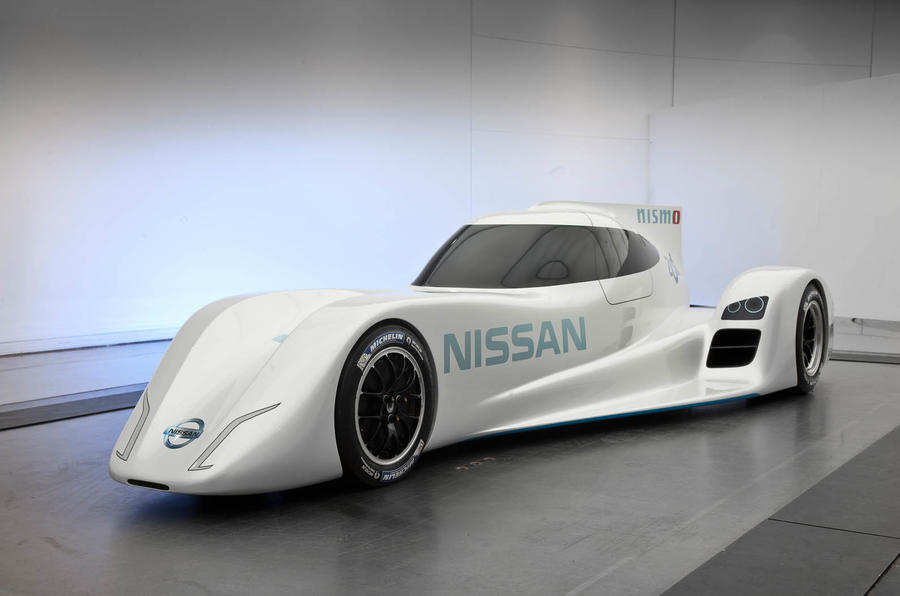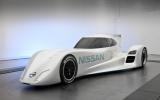Nissan says its new hybrid Le Mans racer, which will compete in the famous 24-hour race in 2014, will provide crucial information about extracting high performance out of electric motors and batteries that will be of benefit to its road car division.
The Japanese manufacturer has been invited back to Le Mans next year in the prized ‘Garage 56’ slot set aside for experimental technology. The new car, unveiled on the eve of last weekend’s 24 hours and bearing the name Zero Emissions On Demand (ZEOD), will be powered by an internal combustion engine and electric motors.
Nissan will test various powertrain combinations before settling on the final specification. The car has been built to be flexible and accommodate several different power iterations during testing. It will, however, use the same core battery technology as used in the Nissan Leaf EV (albeit with uprated battery units to cope with the higher power demands) and will utilise regenerative braking to replenish the energy of the batteries.
Although Audi and Toyota have pioneered hybrid systems in top-level sportscars, Nissan's experimental racer will not be bound by the regulations laid down by the Automobile Club de l'Ouest and so will be free to push the technology more adventurously.
The Audi R18 e-tron and Toyota TS030 utilise hybrid power in short bursts. Depending on the final specification of the powertain, the drivers of ZEOD could be able to switch between electric and ICE power as desired. Project chiefs are keen to see the car complete an entire 8.5-mile racing lap of Le Mans on EV power alone. The car’s super-efficient aerodynamics means it should be capable of about 185mph on the Mulsanne Straight, and Nissan’s calculations suggest it could lap Le Mans quicker than a Ferrari 458 GT2 car, meaning a sub-four minute lap.
“To stand out you need to be different, but not just for different’s sake,” said Darren Cox, Nissan’s global motorsports director. “The low drag, light weight concept is exactly what the road car industry needs to pursue, so it is all relevant technology.
“We already know about battery technology through cars such as the Leaf, but getting electric motors to run at high performance for long periods, that’s the breakthrough that we’ll learn on this.”
The new car adopts the novel narrow-track front axle concept seen on the open-topped DeltaWing, a Nissan-backed project that competed at Le Mans last year, but company chiefs stress that “every last nut and bolt” on its closed-cockpit 2014 challenger is new.
The DeltaWing collaboration ceased earlier this year, with the racing team behind the original car now going it alone in US sports car racing. However, the new Nissan ZEOD is the work of the DeltaWing's designer, Ben Bowlby, who has now been appointed director of motorsport innovation at Nissan.





































Join the debate
Add your comment
No he isn't!
OK, if you take KERS as a generic term for energy recovery, then you are right. But I think the claim is about the more specific KERS reference from F1. In that sense he is wrong.
The Toyota and Audi systems are hybrids - albeit in different configurations.
The Toyota system can run as petrol only, electric only or petrol & electric. KERS cannot do that.
The Audi system can run as diesel only or diesel & electric (they can only deploy electric above 120km/h). This is closer to KERS.
Really?
Given the wider applications of the KERS term - and in particular one directly relevant to the system used at Le Mans by Audi - I would question on what basis you feel it more likely he meant the very narrow, F1-specific version of KERS as opposed to the wider motorsport use of the term. If he'd actually referred to an F1-style system then I would accept that conclusion, but as it stands I see nothing in what Bowlby said which points to that being his meaning. If you would care to highlight what in the context of his comments suggested that to you, I would be grateful.
In addition, how the system goes on to utilise that energy, taking the wider meaning of KERS for a moment, is irrelevant. It applies to the method by which energy is captured. In both Audi and Toyota's case this is by harvesting kinetic energy from one of the axles under breaking, thereby recovering kinetic energy and thereby being a KERS.
Because he's right?
KERS stands for Kinetic Energy Recovery System, and has a wider meaning that purely the systems used in F1. Both Audi and Toyota utilise systems capturing energy under braking (i.e. kinetic energy) and transforming it into electricity to drive a hybrid motor on the drivetrain. That their systems do not rely on the driver pressing a button on the steering wheel as per F1 does not stop the system qualifying as KERS, as the manner in which it operates to store energy is identical. Indeed, the Audi system is based on Williams' aborted flywheel KERS system from F1. With this in mind, Bowlby's description of them as "KERS solutions" is accurate.
OK............so.....?
That's just ONE lap right?, thought Lemans was a 24hr, 1000+lap race?, i'll be impressed when it can do 24hrs.
It's the future.
Correct. After many years developing the technology, this thing couldn't even manage the le Mans 24min race. And they keep telling us EV is the future!